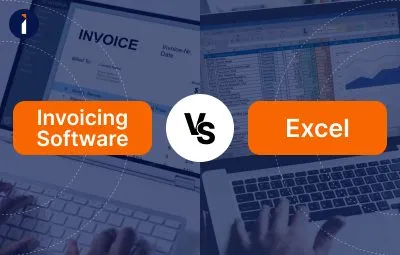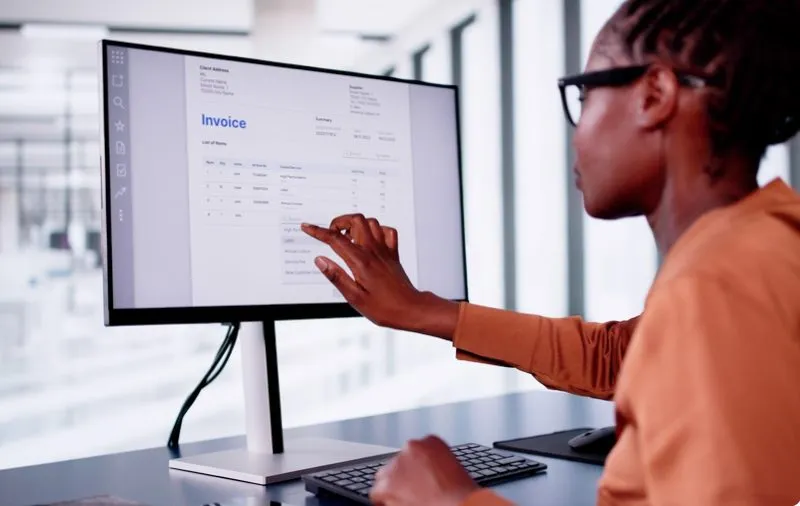Why Invoicing Software is the Better Choice Than Excel

Why Invoicing Software is the Better Choice Than Excel Summary Excel is becoming outdated for invoicing due to errors, lack of automation, and limited growth potential. Using invoicing software is faster, has better reporting features, and runs more accurate calculations than Excel spreadsheets. Some of the extra functionalities of invoicing software include Integration with third-party apps, multi-currency support, and customizations. Moving from Excel to invoicing software can be effective for businesses so they can further improve their operations and revenue. Introduction The process of invoicing is very important for any business as it promotes adequate compensation for services provided. Many businesses rely on Microsoft Excel for invoicing due to its ease of access, but this is becoming less effective owing to progressive technology. So readers, ahead in the blog, we’ll be throwing light on the following: How can using Excel for invoicing be disadvantageous? Why is invoicing software better? How the transition can enhance your business? As businesses grow and evolve, there is a need for a better and more sophisticated invoicing solution. That’s where we get introduced to invoicing applications and software. They not only automate but simplify routine tasks, hence upscaling productivity. Whether you are a freelancer or self-employed, belong to an SMB or a big company, it is crucial to be aware of changes that will make invoicing more sustainable in the future. Why Excel Is Becoming Outdated for Invoicing As firms operate in a dynamic environment characterized by intense competition, it is evident that using Excel to issue invoices is outdated. Although it was highly effective in the past, the following drawbacks make it inefficient in the current ever-evolving business environment: Prone to Human Error The greatest disadvantage of using Excel for billing is that manual intervention may lead to many mistakes. Sometimes, manual data entry may result in miscalculation, wrong amount or misplaced data. These can lead to discrepancies in financial outcomes and erode client trust, making business lose both their time and money. Lack of Automation Excel in particular does not have extra features that can automate invoicing process. All these activities ranging from invoice creation to preparation and dispatch of reminders are done manually, a process that tends to be time-consuming and attracts delays. Without automation, businesses often struggle to keep up with invoicing timelines, leading to cash flow issues. Limited Scalability As businesses grow, their invoicing needs become more complex. Excel can quickly become cumbersome, struggling to handle a growing volume of invoices and clients. This limited scalability can lead to inefficiencies, as users may find themselves overwhelmed by managing numerous spreadsheets and files. Why Choose Invoicing Software Over Excel? Switching to dedicated invoicing software offers numerous advantages that can significantly improve your invoicing processes. These tools not only streamline operations but also enhance accuracy, enabling businesses to focus on growth and better serve their clients. Faster Workflow With Automation Many invoicing softwares perform tasks such as the creation of invoices, reminders on the due dates, and tracking of payments. This automation aids in sorting and processing invoices more effectively, freeing up business teams to engage in other growth strategies. Real-time Reporting and Analytics Through invoicing software, the company receives immediate and comprehensive information on financial performance. Real-time reporting and analytics are useful in decision making, recognizing trends and observing cash flow that helps in better financial management. Accuracy in Calculations Invoicing software ensures precise calculations, significantly reducing the risk of errors associated with manual entry. This accuracy not only helps maintain financial integrity but also builds trust with clients by delivering correct invoices on time. Advanced Features You Can’t Find in Excel Invoicing software offers innovative features that set it apart from Excel, enhancing the overall user experience and improving business efficiency. These functionalities address the unique needs of modern businesses and provide solutions that traditional spreadsheets simply cannot match. Integration Capabilities Most invoicing software solutions easily sync with third-party apps & other business software solutions. This includes accounting software, payment gateways, and CRM. Such integration enhances productivity and the flow of data from one system to another, thereby decreasing the time and energy required to input the same data in both systems. Multi-Currency and Language Support Invoicing software can make international transactions and it allows a business to send invoices in different currency and language. This capability helps to serve international customers, to deal with invoicing matters more easily, and to meet the peculiarities of various areas. Customization and Branding Invoicing software allows businesses to personalize their invoices to reflect their brand identity. Customization options, such as adding logos, adjusting color schemes, and modifying templates, enhance professionalism and customer engagement, making a lasting impression on clients.
How to Automate Your Invoicing Process for Faster Payments

How to Automate Your Invoicing Process for Faster Payments Summary Manual invoicing is slow and error-prone, while automation significantly speeds up the process and reduces mistakes. Automated invoicing ensures faster payments through instant delivery, accurate calculations, and automatic payment reminders to clients. Tools like QuickBooks, Zoho Invoice, FreshBooks, Xero, and Invoicera offer features to streamline invoicing and improve cash flow. Adopting automated invoicing may have challenges, but the benefits of time savings and improved client relationships outweigh the initial hurdles. Introduction As your business scales, handling the invoicing manually becomes extended and demands additional effort and resources. Moreover, it could lead to errors, delays, and cash flow issues. As mentioned above, automation reduces invoice processing tasks to just a few hours, but the question is, “How does it lead to faster payments?” This blog is an answer to this question. Besides, we have also discussed other aspects like: What are the key challenges of manual invoicing How automation solves them Automation tools for faster payments How Invoicera can be the right invoicing tool for your business. Why Invoice Payments Get Delayed? There are several reasons due to which invoice payment gets delayed. A few are discussed below: Invoices are inaccurate or incomplete The invoices sent might have incorrect amounts, be missing important details like taxes, or be outdated information. It can lead to several corrections before the client pays, and this process of correcting invoices takes double the time that it takes to create them. Slow approval process leads to slow payments Manually approving invoices, even if you try your best to make it faster, will be delayed because you need to connect with people to get invoices approved physically. Multiple sign-offs or lengthy review periods contribute to this issue. When you do not send timely payment reminders If you do not send payment reminders, clients may forget or overlook payment due dates which leads to delayed payments. You must regularly follow up to get paid on time. When payment procedures are complex Long payment process that requires a lot of paper work and need manual reconciliation eventually slows down the whole payment cycle. Cash flow issues from the client side Sometimes, payments get delayed when your client is facing cash flow issues. If your client does not have money to pay you, they may delay payments to manage their liquidity. When you do not communicate with clients properly Poor communication between businesses and clients regarding payment terms, due dates, or invoice disputes is also a reason that may lead to late payments and cause disputes between you and your clients. How Automation Ensures Faster Payments It’s time to pop the bubble & find answers to a much-awaited question. Let’s go. It delivers invoices instantly Automated systems make invoice generation so easy, and you can send them with a couple of clicks. It makes the invoice-sending process faster and further speeds up the payment process. It makes almost no errors As you know, automatic calculations can always be accurate. When your invoices contain all the accurate data, such as due amount, taxes, etc., there is no scope for rework, resulting in the client quickly approving and paying the invoice. It sends automated payment reminders Your clients might need to remember to pay you the invoice. However, when automated payment reminders are sent to clients before and after the due date, it helps prompt payments from their side. This, ultimately, reduces the risk of overdue payments. Invoice approval workflows are streamlined Automated workflows speed up the invoice approval process. They completely eliminate paper approvals and make it easy to approve invoices with just a few clicks. Online payment gateways boost payment process The integration of multiple online payment gateways gives your clients the option to pay faster with just a few online steps. Such payment options simplify making payments from anywhere in the world. It offers real-time tracking and reporting When you can view payment reports like outstanding payments, incomplete payments, and rejected invoices in real-time, you can easily fix them by sending reminders or connecting with clients. This visibility helps to resolve any payment issue promptly.
Navigating GST Challenges with Automated Invoicing

Navigating GST Challenges with Automated Invoicing Summary E-invoicing for GST makes billing easier by using digital methods to create and send invoices quickly. Automated invoicing software helps solve common GST problems like wrong calculations and late filings. Using automated invoicing saves time, reduces mistakes, and helps businesses get paid faster. Invoicewale offers tools that make GST invoicing simpler, including auto-calculations and easy tax return filing. Introduction The world of Goods and Services Tax (GST) is filled with many challenges that business entities encounter, most especially when issuing invoices. These challenges often include navigating varying tax rates across states, complying with ever-changing regulations, and managing the complexity of manual invoicing systems. These hurdles can lead to significant delays in invoicing, increased risk of errors, and higher administrative costs, ultimately impacting business profitability. This is where the concept of automated invoicing comes into play. It not only makes compliance easier but also minimizes the necessity of tackling invoices to grow the business. This blog will discuss automated invoicing and how it eliminates some common GST problems. It will also look at the bigger-picture benefits that this brings. Find out how incorporating e-invoicing into your organization can transform the tools and strategies for GST compliance and financial performance, including real-time invoice tracking and the integration of IRP. E-Invoicing and GST as a Powerful Duo E-invoicing is a digital approach to generating, sending, and storing invoices, streamlining the invoicing process and enhancing efficiency. Under the GST system, e-invoicing will involve passing invoices in real time to help businesses meet any legal requirements concerning taxes. Hence, linking to the Invoice Registration Portal (IRP) is essential to meet the e-invoicing requirements. The IRP is the Receipting Interface Point and all e-invoices have to be sent to the IRP where they are validated and approved before being issued out to the customer. This integration enables invoices to conform to the GST standards and helps carry out the eventual reporting and tracking. The government mandate for e-invoicing constitutes the new way of how companies will be handling their invoices. The task is to address issues related to tax evasion, information disclosure, and compliance. Streamlined reporting reduces manual entry and errors by automatically generating GST returns based on e-invoice data. Businesses can monitor their invoices and payments in real-time, improving cash flow management. The IRP ensures that only validated invoices are sent to clients, minimizing the risk of discrepancies. Reduced paperwork and administrative tasks lead to lower operational costs for businesses. Overall, e-invoicing is transforming GST compliance, making it easier for businesses to adhere to tax regulations while benefiting from improved efficiency and transparency. Benefits of Using Automated Invoicing for GST Saves Time It only takes a few minutes to create and send invoices. With features such as pre-designed templates and recurring invoicing, there will be less time spent on paperwork and more on business. It enables you to concentrate more on the crucial aspects of developing your business. Reduces Errors Automation reduces the chances of errors in calculations and data input. Thus, the risk of manual errors in invoices is eliminated, guaranteeing that your invoices are correct and that there is little possibility of compliance complications or delayed payments. Enhances Cash Flow Automated invoicing is an efficient way to receive your payments earlier. For due matters you can also set reminder so that you can call or notify your clients to pay their overdue invoices. This strategy is unarguably proactive in enhancing your cash flow since it allows you to have enough cash for the operations. Improves Compliance Automated invoicing helps your invoices contain all the necessary GST information so that your organization does not face penalties on taxes. This way, you do not have to worry about the issue of taxes while managing or operating your business. Provides Insights Another advantage of automated invoicing is that you get to know the patterns of invoicing with report and analytics data. It can help you know which clients are timely with their payments, understand the revenue patterns, and make strategic decisions for your practice’s growth. Streamlines Record Keeping Retrieving past invoices is easy since most automated software keeps all your invoicing records in one place. This kind of organization helps minimize your accounting hassles, and makes it easy to prepare for audit tests or GST return.

